Rollerblading is one of the coolest and most rewarding activities that you can enjoy outdoors. Besides being tons of fun, it’s also an excellent way to stay in shape because roller skating has some serious health benefits.
In today’s article, I will go over how to rollerblade. You’ll find everything you need to learn inline skating, including an in-depth guide that walks you through every step.
I also have another page to help you learn how to roller skate on quads if you’d rather learn on classic skates. And, if you’re not sure which type of skates are best for you, then check out my Rollerblades vs Roller Skates vs Inline Skates page.
I am an avid roller skater who has been skating for over 30+ years. I have tried to condense everything a beginner needs to know to learn how to rollerblade into this article. I hope you use the information and drawings here to learn skating.
So without further ado, grab your rollerblades and lets start skating!
Learning to Rollerblade: A Step by Step Guide
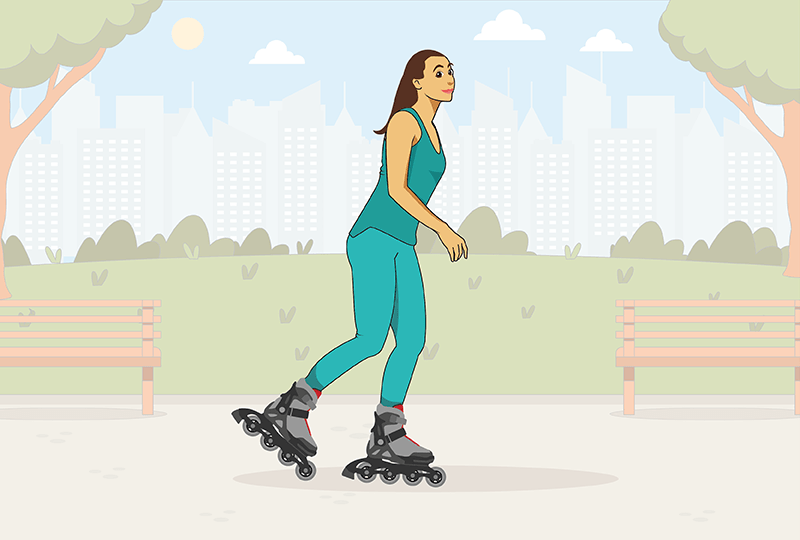
1. Find the Right Practice Spot
A lot of beginners are so excited about rollerblading that they overlook many essential aspects and guidelines that they should follow. Mainly, skate in a safe place.
First, make sure that your spot is a flat area with no noticeable bumps, debris, cars and other people around. All of these items can throw you off your footing. The surface should also be flat. Stay away from hills. Even a lot of experienced skaters struggle with hills.
A skate park, roller rink, garage or a regular park are all great places to learn to skate.
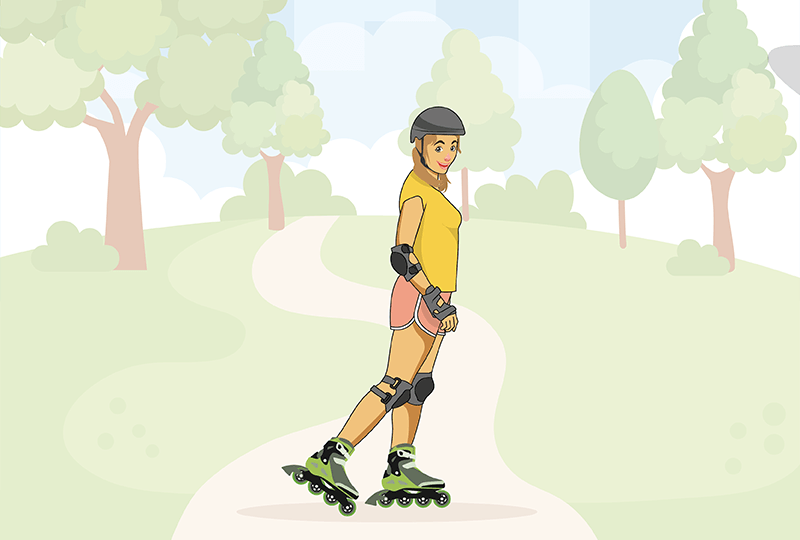
2. Get the Right Rollerblading Gear
Next, you need a good pair of rollerblades and some safety equipment. Lets go over that next.
Selecting Your Roller Blades
A great rollerblade for beginners is the Bladerunner by Rollerblade. Here is the BladeRunner for women, men, boys and girls. It’s the same rollerblades for each, just different colors and boot sizes.
I have written several articles about the best rollerblades in detail, so I’m not going to cover that here. Please see my articles on the best rollerblades for men, women and kids.
Picking the Right Safety Gear
It’s important as a beginner to protect yourself. The #1 reason most people stop skating is because they are tired of hurting themselves when falling.
Helmet
The most important thing to protect when you are doing any kind of activity is your head. A great helmet for beginners is the Triple 8 Sweatsaver Helmet (Amazon).
Check out my best roller skate helmets article for more my full reviews of each.
Knee Pads, Elbow Pads, Wrist Guards & Padded Shorts
The next thing to do is buy yourself a good pair of wrist, knee and elbow pads. You can get the Triple 8 pads pack (Amazon) that has all of those pads and is great for beginners. I also recommend a butt pad (or padded shorts) and even a mouth guard (Amazon) for beginners who know they are going to fall a lot. Your tailbone and teeth will thank you for it.
Check out my best roller skate pads article for reviews on multiple products to protect yourself.
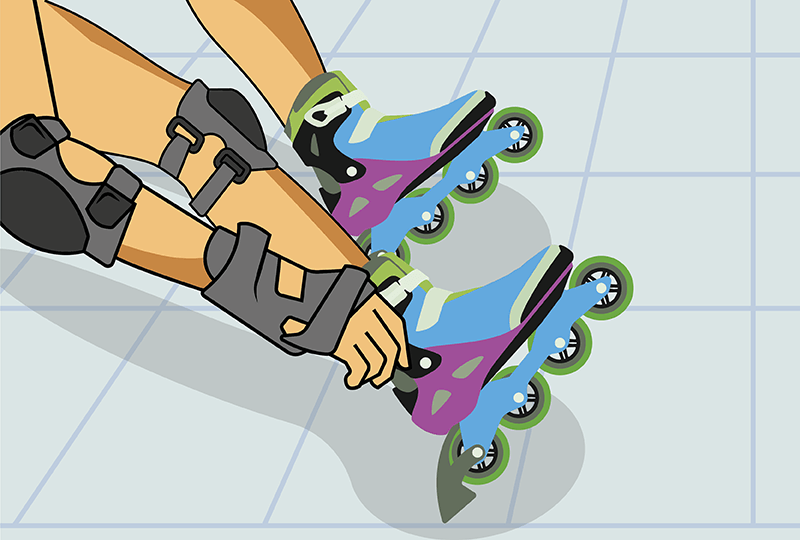
3. Start on the Ground & Lace Up
Now that you have your rollerblades, helmet, knee and elbow pads and wrist guards on, you are ready to get started!
Next, sit on the ground and lace up your skates. Make sure your feet are snug in the rollerblades. They should feel like a good pair of shoes (only heavier). Tighten the strap on your rollerblades until your ankle is snug.
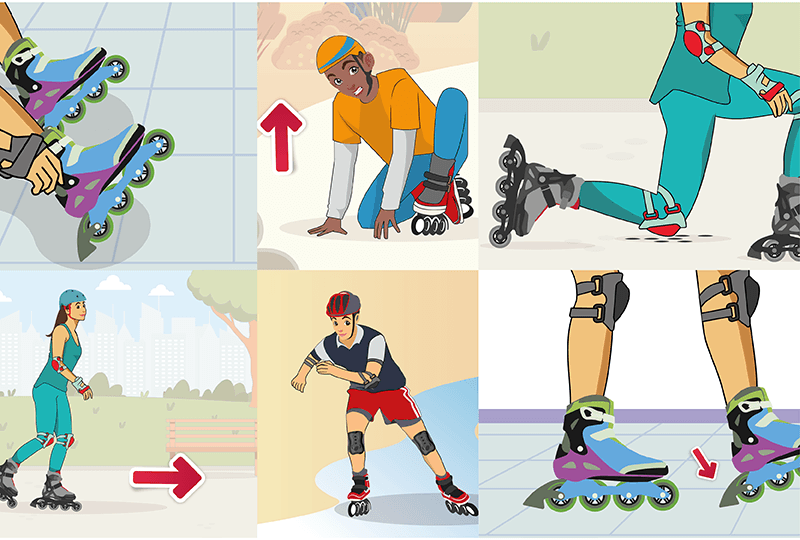
4. Learn How to Stand Up on Rollerblades
I have taught hundreds of people how to skate in my lifetime. The most common question I receive from beginners is, “Why do we have to start on the ground? I want to skate!”
And the answer is always the same. You will skate, but first you have to learn how to stand up and fall down. The main reason you need to start on the ground is because you need to learn how to get up from a fall the correct way.
Here are the steps to get up correctly from the ground in roller skates:
- While seated, spin around and kneel on both of your knees.
- Lift one foot forward and place the blade on the ground while keeping your other leg’s knee on the ground. In football we called this “taking a knee”. Tim Tebow style.
- Now, the moment of truth. From this one knee position, use your hands to push down on your front leg’s quad/knee and bring your other foot up to push yourself into a starting position.
- Place both feet firmly on the ground. If you begin to roll accidentally, use your rubber stopper brake by pushing the heel with the brake down. Or, you can put one skate behind the other in L or t shape. We call this a T stop. If you are struggling balancing, put your hands out in a T shape to stabilize.
- Congratulations! You have successfully stood on skates. Way to go!
5. Learn to Fall Down Safely
Next, we need to learn how to fall down safely. I know you are anxious to move, but this step is crucial to not getting injured.
The goal here is not to eliminate falling down. You are going to fall sometimes. The goal is to keep you skating because we are trying to minimize the severity of your falls.
3 Ways to Fall Safely on Rollerblades
It goes without saying, but beginner roller skaters need to go slow, avoid hills, debris and other objects (like cars and pedestrians). Carpet or grass is a perfect place for a beginner to practice with skates on. This allows you to get used to walking in your rollerblades and practice new stances, postures and moves.
For practicing all of these falls below, please make sure to put on your pads and helmet. Then, move onto carpet or a nice patch of grass. This helps to control your skates and gives you a softer place to fall safely.
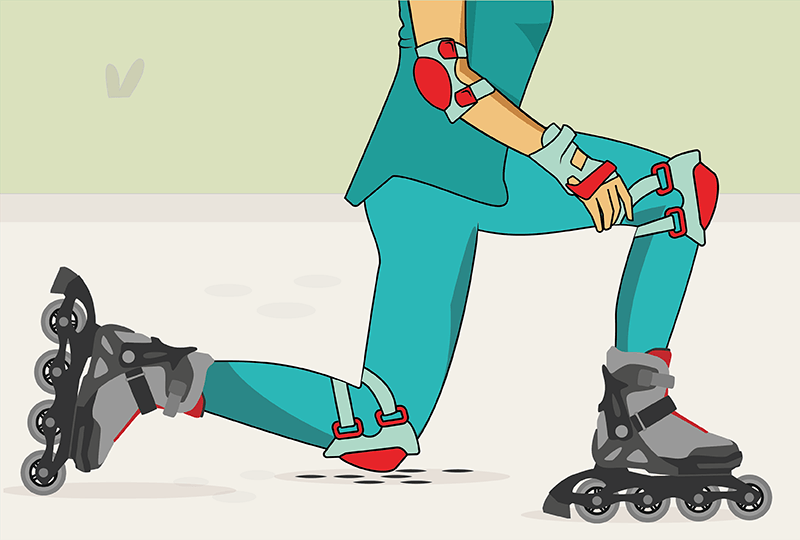
Take a Knee
One safe way to fall when you are going slow is to drop down and take a knee. Of course, you need knee pads on to perform this step. As you are feeling shaky and feel like you are about to fall, get low to the ground on your rollerblades and drop down slowly to one knee. This will slow you down until you come to a complete stop.
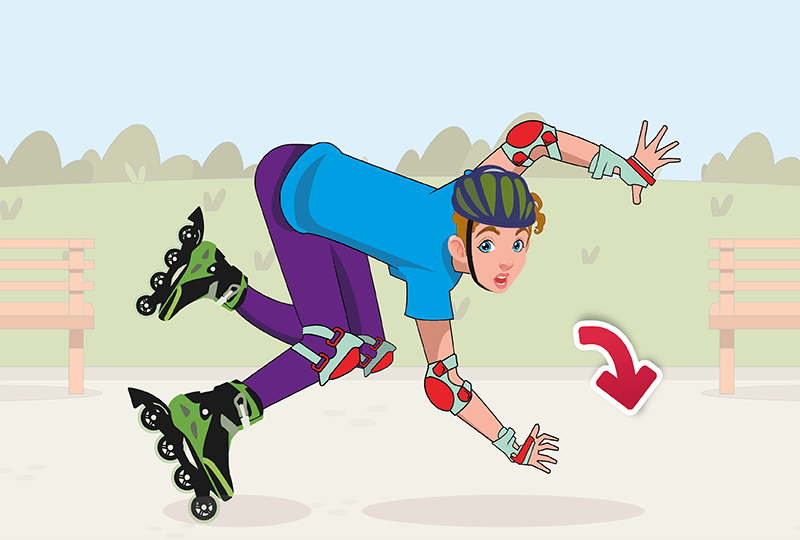
Falling Forward
When you fall forward, try to have your pads take the brunt of the force. Wrist guards and knee pads are pretty much a necessity when you are first learning because most people fall forward on their hands, knees and elbows.
Falling forward is similar to taking a knee except you are going to want to try to fall down onto both knees at one time. When you can’t control your fall, your body also will come down on your hands, too. Try to remember to keep your elbows bent when you fall so that you don’t hyperextend your elbows when your hands hit the ground.
You want to fall forwards. That is the best way to fall. Keep your knees bent and shift your weight a little forward when skating. This will ensure that when you fall it will be forwards.
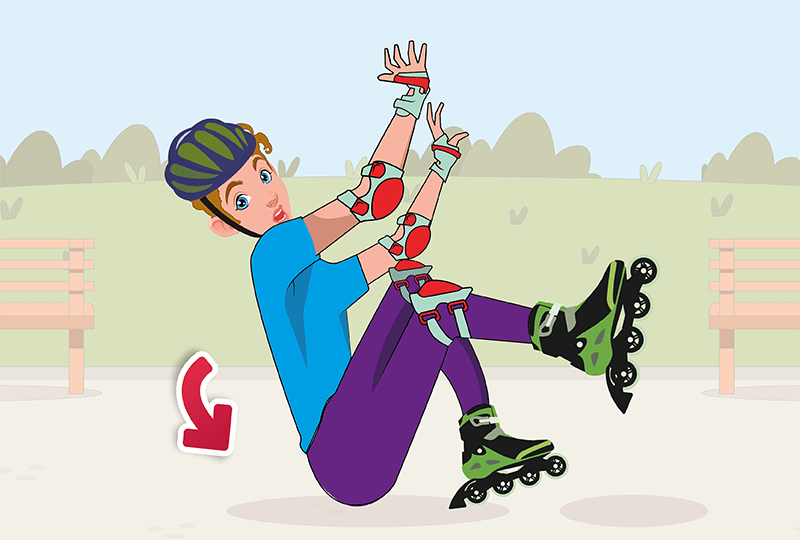
Falling Backwards
This is by far the worst way to fall. I have had multiple falls going backwards in my skating career, and they are by far the scariest and most injury prone.
I have bruised my tail bone, broken the radial bone in my elbow and received stitches multiple times in the past 30+ years. These were all falls I had while travelling at high speeds and without pads – something you should never do on roller blades when you are first trying to learn. So, don’t worry too much. Here in the very beginning, if you are going slow and pacing yourself, you should not have any injuries to that magnitude. Maybe a few bumps, scrapes and bruises, but hopefully no breaks or stitches.
The key to falling backwards is to try and turn slightly as you are falling. If you are falling straight back, you want to turn slightly to one butt cheek or the other to absorb the fall.
Falling on a fatty part of your bottom is much better than falling straight back on your tailbone. Falling on the tailbone can easily put you out of commission for weeks. And, it takes longer for me to recover from my injuries as I age. So, when in doubt….go slow.
If you are falling backwards a lot, then you are not bending your knees enough and you are not leaning forward. If you are standing straight leg like a mummy all the time, then you are going to have a hard time. Bend the knees and lean slightly forward. This will help to prevent backwards falls.
For those super scared of falling backwards and bruising their bottoms, check out the padded shorts I recommended earlier. They do look funny, but they can be worn under some sweat pants with a lot of room in them. They do work and will keep you from bruising your tailbone.
Final Beginner’s Tip on Falling
If you are falling a lot, stay in the grass and carpet until you get better at balancing on your skates. Balance is the key to roller skating, whether it is on blades, inline skates or quads.
6. Practice the Right Stance
Now, that we have all that falling out of the way, lets get to skating! In a standing position, place both feet facing forward. Keep your feet shoulder width apart. Keep your knees bent and lean slightly forward. Your back should be upright with a slight bend forward. This is the proper skating stance for rollerblading.
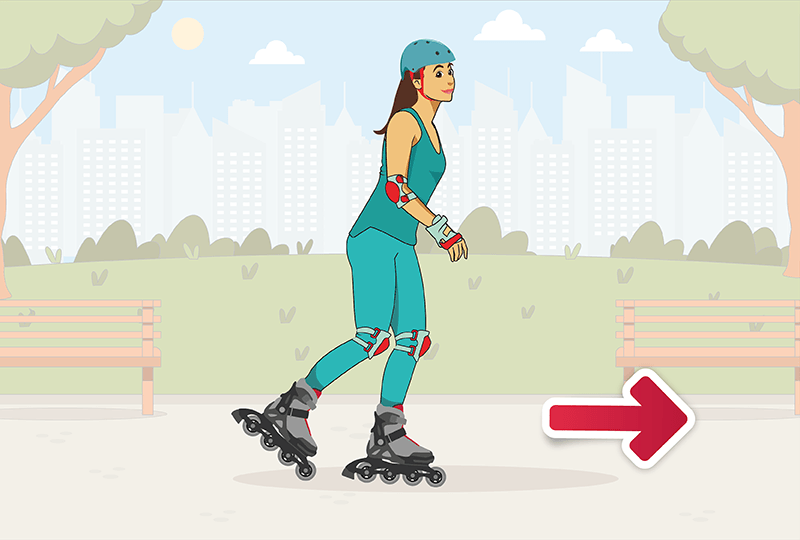
7. Walking on Rollerblades
Next, we are going to practice walking while in our rollerblades. This again is best to practice on carpet or grass to keep you from rolling. Plus, if you do fall at this stage, you have a nice, safe, padded spot to fall.
While in the proper stance on your skates, put one foot forward. Then, take another step to bring the two skates back together and back into the proper skating stance. Keep practicing putting your right foot forward and then bringing your back foot up to meet it.
If it feels weird to walk on skates, then practice for several days on grass or carpet until it seems more natural. It’s okay to go slow. That is normal. When you are ready, move on to the next step.
8. How to Stop on Rollerblades
Before we begin actually blading, we need to make sure we know how to stop. I am going to show you 3 quick ways to stop from easiest to hardest. I cover almost a dozen ways to stop on skates which most work for rollerblades, too. However, these are the three that I would focus on as a beginner.
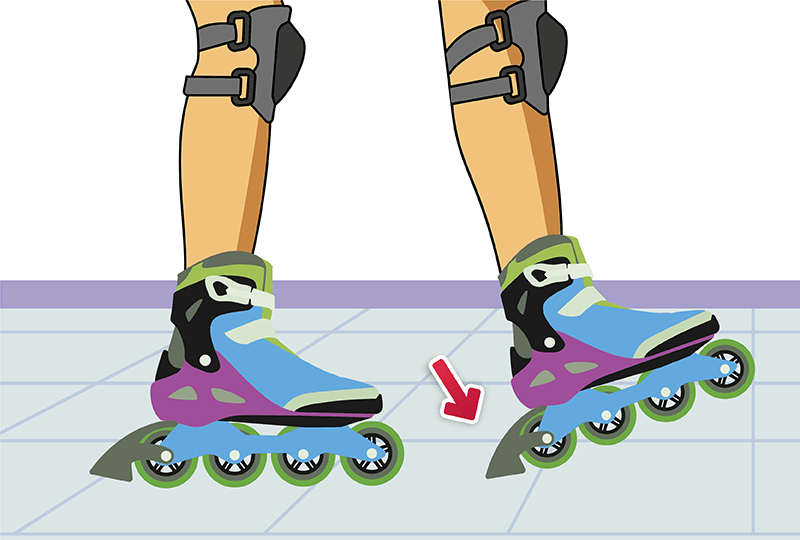
Use the Heel Brake
All of the best beginner rollerblades come with a brake on the back of at least one of the blades. This is a small rubber toe stop. You should practice using it on the grass or carpet so you know how it feels to stop before you get rolling.
To apply the brake on a pair of blades, tilt your brake foot until it makes contact with the ground. When you are rolling, this will slow you down. Practice applying the brake and then coming back to the proper skating stance.
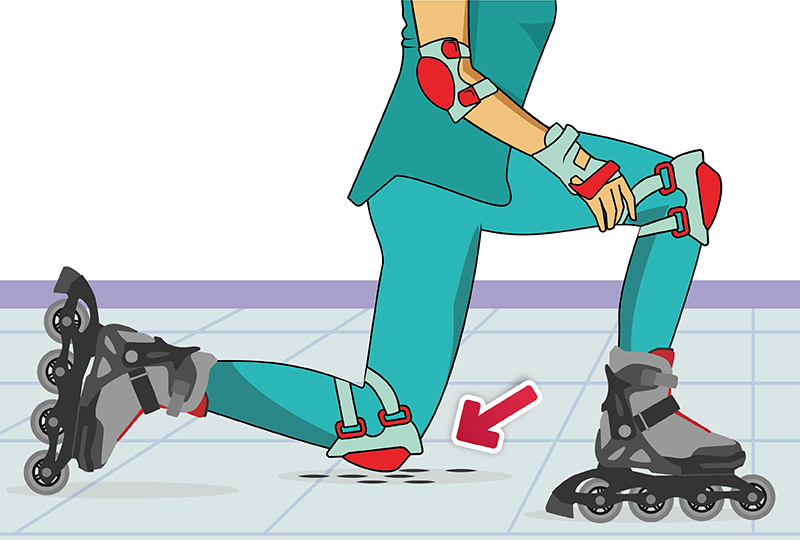
Take a Knee
I mentioned this already in the how to fall section above. Taking a knee is another good way to stop if you are going at a slow speed. Simply bend down and place your knee pad on the ground and allow it to bring you to a stop.
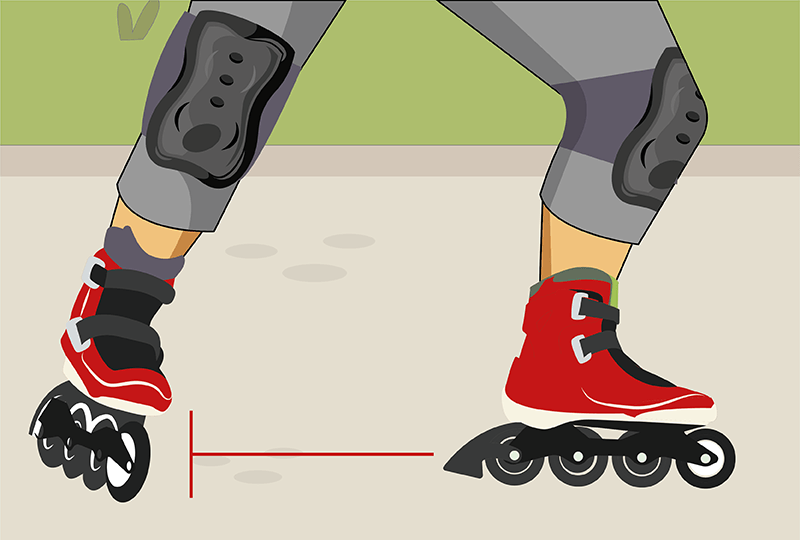
The T Stop
This move is a little more advanced, but still one beginners can easily do once they find there balance. Take one foot and turn it 90 degrees perpendicular to your other foot. Then, place this foot behind your blade that is facing forward. Your feet will make a T (or L) shape on the ground. As your front foot is rolling forward, the back foot is placed in this T stop shape and is dragging across the ground. This brings you to a stop.
Check out my article on how to stop on roller skates for a lot more ways to stop. However, the three above are the ones I recommend most for beginners.
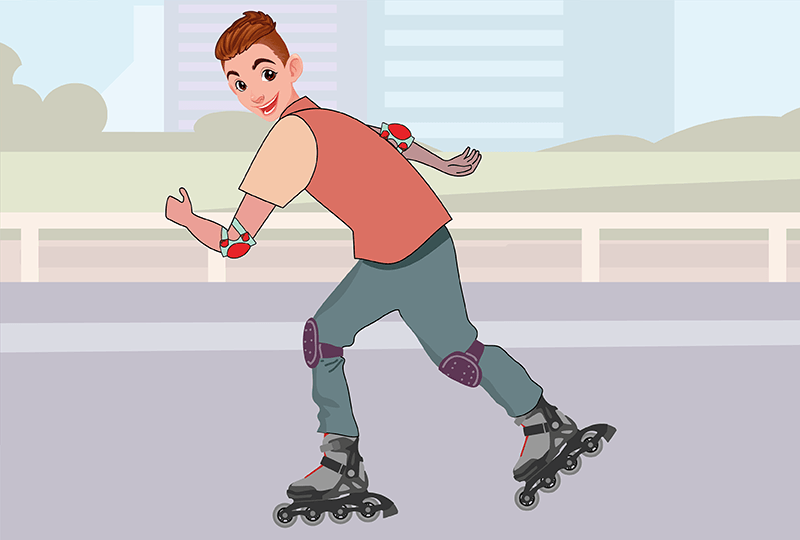
9. Gliding on Rollerblades
Now we are finally ready to glide or roller skate. Stand in the proper skating stance. Next, move off the carpet or grass surface onto a hard, flat surface. Next, take a step forward. Your wheels will roll. Maintain your balance. Put your arms to either side of you to help keep you upright.
While standing, take a step forward with a single skate. Then, place the skate down and you will begin to roll or glide.
To take the next step, use the planted foot (the one you didn’t step with) to push off to the side. This will propel you forward. Continue taking a step and pushing with the other foot.
Now, don’t get too carried away. Otherwise, you’ll build up too much speed and lose your balance. Expect falling several times in this step, but hang in there and it will come to you!
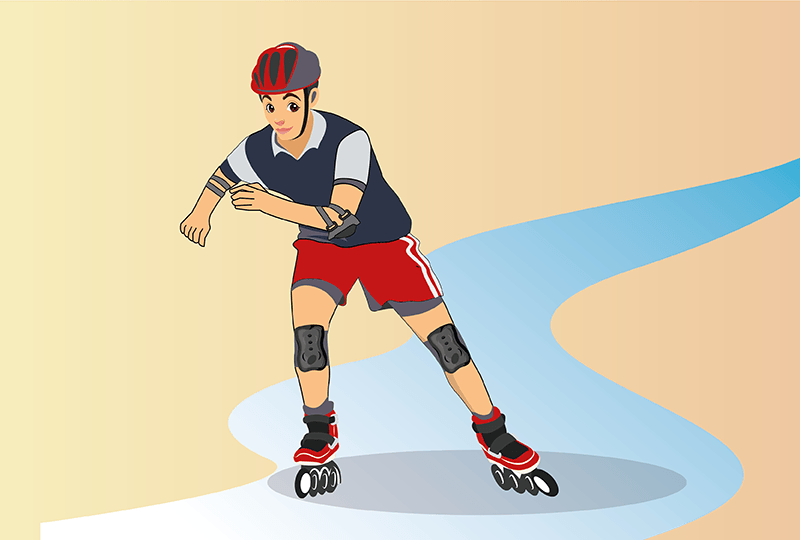
10. Steering & Learning to Turn
Now that you know how to glide and stop, you can advance to using your body weight to steer the rollerblades.
To steer in rollerblades, you need to keep yourself balanced and slightly lean to the left or right. As you skate, your rollerblades need to both be leaning in the same direction.
Simply shift your weight ever so slightly towards the left and extend your ankles to make a left turn, and vice versa for the right side.
Another technique is known as scissors. Once you are moving forward, scissor the leg opposite to the direction of the turn forward. If you’re turning left, for instance, scissor your right foot over and in front of the left. Bend the corresponding leg into the turn as your right leg swings out and back to its starting position as it stabilizes the change in direction. Once you have the hang of it, you can speed up a turn by rotating your torso as your scissor legs swings around.
Learn More Rollerblading from the Roller Skate Dad Newsletter!
If you are interested in more advanced rollerblading, then be sure to sign up for the Roller Skate Dad newsletter. In my regular newsletter, I send out roller skating tricks and tips. Learn backward skating, how to do crossovers, backward skating crossovers, two foot turns, one foot turns, shoot the duck, spins, waltz jumps and more. I also cover topics like the Best Roller Skates and the Best Inline Skates on the market today.
Q&A
Will previous experience in ice skating help you learn rollerblading quicker?
Ice skating is extremely similar. Both activities require balance and the same centering of your body weight. However, ice skates don’t have a built-in rubber stopper.
Can you learn rollerblading as an adult with no previous experience?
Learning to blade is a lot easier when you’re young because kid’s bodies are far more flexible and their muscle memory is already set to the learning mode. The ideal age to start rollerblading is between the age of 7 to 10 years old. However, adults can learn to blade even with no prior experience. All you need is patience, learn the basics and continue practicing!
How much time does it take to learn how to rollerblade?
The answer to this question is it depends. How often are you willing to practice? The more you practice, the quicker you will get good at rollerblading. However, most skaters take anywhere from 3 to 6 months of bi-weekly training for one or two hours to be able to skate freely.
Wrap Up
Well, after reading through this article, I hope you are well on your way to inline skating like a pro. Now, strap on those blades, get your protective gear and get out there and skate!
Want to Learn Even More About Skating?
Want more reviews on roller skates? Check out my Best Roller Skates page for a list of all of the quads I recommend. I also have pages for roller skates for men, roller skates for women and roller skates for kids where I recommend the best skates on the market today for each group. Or, check out my roller skates for beginners if you are completely new to roller skating.
Or, if rollerblades or inline skates are more your style, then check out my rollerblades for men, rollerblades for women or rollerblades for kids pages. Or, if you are completely new, check out my rollerblades for beginners page.
